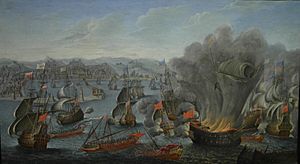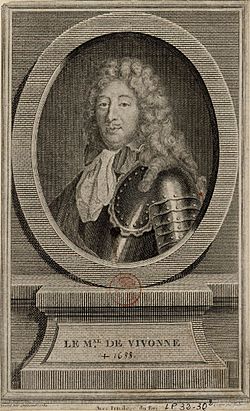Battle of Palermo facts for kids
Quick facts for kids Battle of Palermo |
|||||||
|---|---|---|---|---|---|---|---|
| Part of the Franco-Dutch War | |||||||
 A painting of the battle by Pierre Puget |
|||||||
|
|||||||
| Belligerents | |||||||
| Commanders and leaders | |||||||
| Strength | |||||||
| 30 ships of the line 9 fireships 10,000 crewmen |
27 ships of the line 23 fireships 13,000 crewmen |
||||||
| Casualties and losses | |||||||
| ~500 killed and wounded | ~3,000 killed and wounded 1,000 captured 12 ships of the line destroyed 5 small ships destroyed |
||||||
The Battle of Palermo was a major naval battle. It happened on June 2, 1676, during the Franco-Dutch War. This fight took place near Palermo, a city in Sicily.
The battle was between the French navy and a combined force of Dutch and Spanish ships. France had sent its fleet to help people in the city of Messina. These people were rebelling against Spanish rule in Sicily.
What Led to the Battle
Before this battle, the Dutch and Spanish fleets were in a bay. They were busy repairing their ships. This was because of an earlier fight called the Battle of Augusta. In that battle, the famous Dutch Admiral Michiel de Ruyter was badly hurt and later died.
His death really lowered the spirits of the Dutch sailors. Command of their fleet went to Vice Admiral Jan den Haen. The Spanish admiral, Don Diego de Ibarra, took overall charge of the combined forces.
Meanwhile, the French fleet arrived from Messina. It was led by the Duke of Mortemart. However, the real battle plans were made by experienced admirals like Abraham Duquesne, Anne Hilarion de Tourville, and Jean Gabaret.
The Dutch wanted to fight the French at sea. But they were disappointed with how the Spanish had acted in the previous battle. So, the Dutch and Spanish ships lined up across the bay. Spanish galleys (rowing ships) were placed in front. They were there to protect against enemy fireships. A fireship was a vessel filled with flammable materials. It was set on fire and sent into enemy ships to burn them.
The French fleet was bigger and stronger. Many Spanish ships were old and had weak cannons. Their crews were also not fully trained. The Dutch crews were very skilled. But they had lost many sailors in past battles. Also, a sickness was spreading among them. The French planned to attack the Spanish ships first. Then they would fight the Dutch ships and shore cannons. Their goal was to create a lot of smoke. Under this smoke, their fireships would attack.
The Battle Begins
The Spanish ships could not hold their battle line for long. Many of them cut their ropes and left the fight in a hurry. Three Spanish frigates (smaller warships) caught fire. This happened because French fireships attacked them. Two Spanish galleys were destroyed by cannon fire. Admiral Juan de Villaroel was killed on one of them.
When the Spanish resistance on the right side of the line broke, the French attacked. They focused all their power on the left and center. This part of the line was mostly made up of Dutch ships.
The main Spanish ship, the 70-gun Nuestra Señora del Pilar, was attacked. Four French fireships hit it. The ship caught fire and then exploded. About 200 sailors died, along with both Spanish admirals, de Ibarra and de La Cerda.
Most of the Dutch losses came from another successful French fireship attack. The 68-gun Steenbergen was hit. It crashed into two other Dutch ships, the 50-gun Vrijheid and the 36-gun Leiden. This happened as they tried to get away. All three Dutch ships caught fire and exploded. Luckily, most of their crews managed to escape. Rear Admiral Pieter van Middelandt was killed on board the Steenbergen.
Even with these losses, the Dutch kept fighting. Vice Admiral den Haen was killed by a cannonball. He was on his flagship, the 76-gun Gouda. With all the Dutch and Spanish admirals dead, Captain Gerard Callenburgh took command. He was on the 76-gun Eendracht. One of the Spanish cannons on shore exploded. The town itself also caught fire.
The Dutch and Spanish were in a very bad situation. However, the French had used up all their fireships by this point. So, Vivonne ordered his fleet to return to Messina.
After the Battle
Some people thought the French could have completely destroyed the Dutch and Spanish fleets. But this would have meant more French losses. Vivonne decided that the battle was already won. He thought it was better to return without losing any of his own warships.
The French victory did not change much in the long run. The French forces in Sicily were called back on January 1, 1678. Just like in the Franco-Spanish War of 1635-1659, Spain managed to keep its control in Italy. France's hopes of gaining a lot of land there did not come true.
Images for kids
-
A painting of the battle by Pierre Puget




